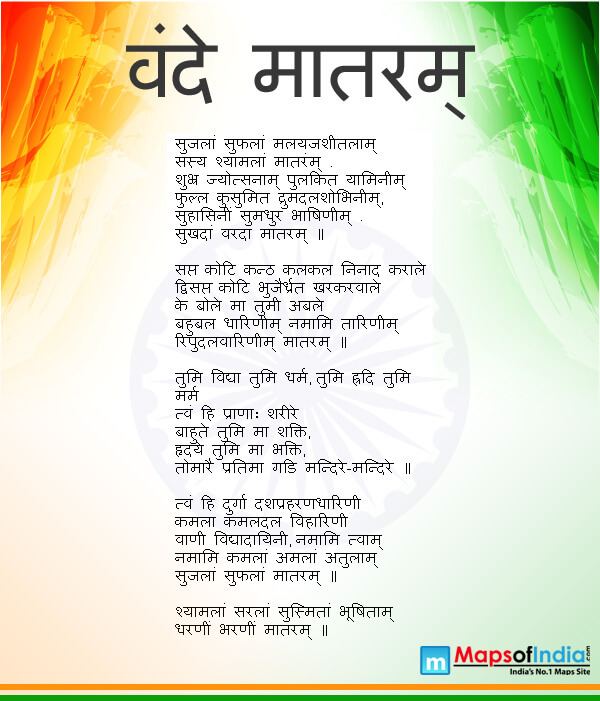National Song of India - Vande Mataram
Vande Mataram!
Sujalam suphalam, malayaja shitalam,
Shasyashyamalam, Mataram!
Shubhrajyotsna pulakitayaminim,
Phullakusumita drumadala shobhinim,
Suhasinim, sumadhura bhashinim,
Sukhadam, varadam, Mataram!
Saptakotikantha kalakala ninada karale
Dvisaptakoti bhujair dhrita-khara karavale
Abala kena ma eta bale
Bahubala dharinim, namami tarinim,
Ripudalavarinim Mataram!
Tumi vidya, tumi dharma,
Tumi hridi, tumi marma,
Tvam hi pranah sharire!
Bahute tumi ma shakti,
Hridaye tumi ma bhakti,
Tomarayipratima gari mandire mandire!
Tvam hi Durga dashapraharana dharini,
Kamala, Kamaladalaviharini,
Vani, vidyadayini namami tvam,
Namami Kamalam, amalam, atulam,
Sujalam, suphalam, Mataram,
Vande Mataram!
Shyamalam, saralam, susmitam, bhushitam,
Dharanim, bharanim, Mataram!
Vande Mataram is a hymn to the Mother Land and played a crucial role in the Indian independence movement. It was first sung by Rabindranath Tagore in a political perspective at the 1896 session of the Indian National Congress. In 1950, the first two verses of the song were given the official status of the "National Song" of India.
On 20 November 1909, the complete poem translated by Sri Aurobindo in prose appeared in Karmayogin, a weekly newspaper. Sri Aurobindo also translated the Vande Mataram into a verse structure which is known as "Mother, I Bow to Thee".
The concept of Vande Mataram is usually believed to have come to Bankim Chandra Chattopadhyay around 1876 when he was a government official. He wrote the poem in the spur-of-the-moment using Sanskrit and Bengali words.
In 1882, the poem was published in his book Anandamath, which is set in the backdrop of the Sannyasi Rebellion. After the poem was written, Jadunath Bhattacharya was asked to compose a tune for it.
During the Indian independence movement, "Vande Mataram" was the national call for freedom in India. Large rallies would incite themselves in a patriotic passion by shouting the slogan "Vande Mataram".
The song has been composed to many tunes, with the oldest audio recordings dating back to 1907. Throughout the 20th century, over a hundred different versions of the song have been recorded. Many versions comprise of traditional South Asian classical ragas.
Different versions have been visualised in a number of films and also for the All India Radio. The most popular version of the song in recent years is the one composed by A. R. Rahman in 1997, as part of the 50th Independence anniversary of India.
Last Updated on : July 29, 2016
